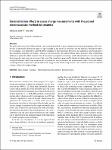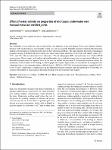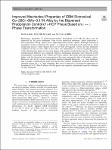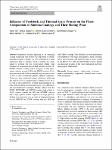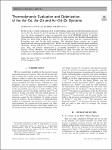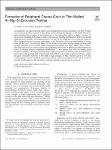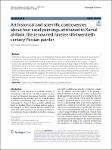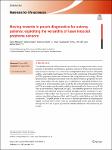Search
Author
- Osman, Ahmed I. (5)
- Daqing, Ma (3)
- Jorgensen, Ed (3)
- Li, Yan (3)
- next >
Subject
- kinh tế (26)
- Economics (12)
- programming (10)
- XRD (10)
- next >
Date issued
- 2020 - 2025 (2129)
- 2010 - 2019 (129)
- 2000 - 2009 (9)
- 1999 - 1999 (1)
Has File(s)
Search Results
Graphene is a suitable transducer for wearable sensors because of its high conductivity, large specific surface area, flexibility, and other unique considerable features. Using a simple, fast galvanic pulse electrodeposition approach, a unique nonenzymatic glucose amperometric electrode was successfully developed based on well-distributed fine Cu nanoparticles anchored on the surface of 3D structure laser-induced graphene. The fabricated electrode allows glucose detection with a sensitivity of 2665 µA/mM/cm2, a response time of less than 5 s, a linear range of 0.03–4.5 mM, and a LOD of 0.023 µM. It also detects glucose selectively in the presence of interfering species such as ascorbic acid and urea. These provide the designed electrode the advantages for glucose sensing in saliva w... |
The pulsed electroacoustic (PEA) method is an established method for space charge measurements in polymeric dielectrics. In view of the poorly understood impact of space charge on the electrical resistivity and the dielectric breakdown behavior of ceramics, it is desirable to adapt the PEA technique to these materials. However, this adaption is non-trivial due to the constitutive properties of ceramics, which are, at least in part, very different from that of polymers. This contribution addresses a particular effect related to the electrostrictive properties of ceramics on the theoretical level. It is shown that these properties may cause an inversion of the sign of the sound wave generated by electrical voltage pulses when compared to typical polymers, which may in turn result in a... |
The weldability of steel under the water is limited due to the influence of the environment. Water causes limited visibility, presence of the residual stresses, increasing the cooling rate, and increasing the diffusible hydrogen content in deposited metal, leading to the formation of brittle microstructures in heat-affected zone (HAZ). The paper presents the results of mechanical properties testing of S420G2+M steel welded joints made with covered electrodes in the water with salinity values: 0‰, 7.5‰, and 35‰. The non-destructive tests: ultrasonic (UT) and radiographic (RT), and destructive tests: Vickers HV10 measurements, Charpy impact, and bending and metallographic macro- and microscopic tests were performed. |
Mechanical properties of electron-beam-melted biomedical Co–Cr–Mo–N alloys can be improved by the grain refinement from reverse transform treatment, which transforms a low-temperature strong ε-phase into a high-temperature ductile γ-phase. Although mechanical properties of alloys consisting of a single ε- or γ-phase have been previously reported on, those comprising mixed ε- and γ-phases have not yet been investigated. Herein, the heat treatment conditions of the Co–28Cr–6Mo–0.11N alloy were determined to control the phase fraction while obtaining fine grains in the mixed phases with superior mechanical properties. The phase transformation behavior was analyzed. Superior mechanical properties were observed in the mixed phases containing 70 pct γ-phase and 30 pct ε-phase. |
Suspension thermal spraying is an emerging coating technology that enables the deposition of dense-structured ceramic coatings. As wear resistance is a main application field of alumina (Al2O3) coatings, this study aimed to evaluate the dry reciprocating sliding wear resistance of suspension sprayed high velocity oxy-fuel (S-HVOF) alumina coatings and to compare it with atmospheric plasma sprayed (APS) and HVOF coatings. Coatings were analyzed in the as-sprayed state and post-treated at 910 °C (hot isostatically pressed, HIPed) conditions. Wear tests were conducted using a tribometer, following the ASTM G133-02 standard and a sintered WC-6 wt.% Co ball as the counterbody. Coating characterization was done using scanning electron microscopy, x-ray diffraction and nanoindentation tech... |
In this work, a critical evaluation of all available phase diagrams and thermodynamic data for the As–Cd, As–Zn and As–Cd–Zn systems has been performed and thermodynamic assessments over the whole composition ranges are presented using the CALPHAD method. To predict thermodynamic properties and phase equilibria for these systems, the Modified Quasichemical Model for short range ordering was used for the liquid phase and the Compound Energy Formalism was used for the solid solutions. The optimized binary systems are in good agreement with existing experimental data. Within the ternary system predicted phase equilibria, the ZnAs2−CdAs2
and Zn3As2−Cd3As2
sections are in good agreement with the experimental data. Also, the eutectic temperature is accurately optimized for ZnAs2−Cd3As... |
Investigations on microstructure and texture development during processing of Al–Mg–Si sheet and extrusion profiles focused on describing and modelling the changes in the bulk. However, understanding the evolution of microstructure in the sub-surface region is highly relevant, as this governs material performance under corrosion and bending deformation, which are crucial applications in mobility and transportation. The aim of this study was to correlate the effect of alloy composition and extrusion parameters to the formation of texture and peripheral coarse grain (PCG) layer. For this, five alloys of the AA6xxx class with varying content of dispersoid forming elements were extruded at increasing extrusion speeds into thin-walled hollow profiles. The microstructure at a plane sectio... |
Pigments on four easel paintings signed by Mohammad Ghaffari (latter Kamal al-Molk), the renowned Persian painter lived from the mid-nineteenth to the mid-twentieth century, kept at the Astan-e Qods-e Razavi Museum (AQRM) in Mashhad, Iran, were identified by micro-X-ray fluorescence (µ-XRF), scanning electron microscopy—energy dispersive X-ray spectrometry (SEM–EDS) and micro-Raman spectroscopy (µ-Raman). Apart from chrome yellow, green chromium oxide and red ochre, four blue pigments including Prussian blue, artificial ultramarine blue, azurite, blue phthalocyanine PB:16 and seven white pigments including rutile, huntite, lead white, baryte, chalk, gypsum and zinc white were identified on the paintings. Based on the occurrence of rutile and blue phthalocyanine PB:16 and the fact th... |
The microstructural and mechanical effects of various single-step (SS) and double-step (DS) quench and partition (Q&P) heat treatments applied to an AISI 420A low carbon martensitic stainless steel (MSS) has been studied. The goal with this work is to reach a total elongation (E pct) of 12 pct and an ultimate tensile strength (UTS) above 1200/1300 MPa, but ultimately to achieve a superior strength-ductility balance in comparison to its traditional Quench and Temper (Q&T) counterpart. This is being done by retaining austenite within the steel’s martensitic matrix at room temperature (RT) using novel SS and conventional DS Q&P heat treatments. Considerable work has been done to optimize DS Q&P heat treatments, but little has been done to understand the effects of removing a subsequent... |
The development of a 3D printed sensor for direct incorporation within stoma pouches is described. Laser induced graphene scribed on either side of polyimide film served as the basis of a 2 electrode configuration that could be integrated within a disposable pouch sensor for the periodic monitoring of ileostomy fluid pH. The graphene sensors were characterised using electron microscopy, Raman spectroscopy, DekTak profilometry with the electrochemical properties investigated using both cyclic and square wave voltammetry. Adsorbed riboflavin was employed as a biocompatible redox probe for the voltammetric measurement of pH. The variation in peak position with pH was found to be linear over pH 3–8 with a sub Nernstian response (43 mV/pH). The adsorbed probe was found to be reversible a... |


